spare tire CADILLAC SEVILLE 1997 4.G Owners Manual
[x] Cancel search | Manufacturer: CADILLAC, Model Year: 1997, Model line: SEVILLE, Model: CADILLAC SEVILLE 1997 4.GPages: 370, PDF Size: 20.52 MB
Page 75 of 370
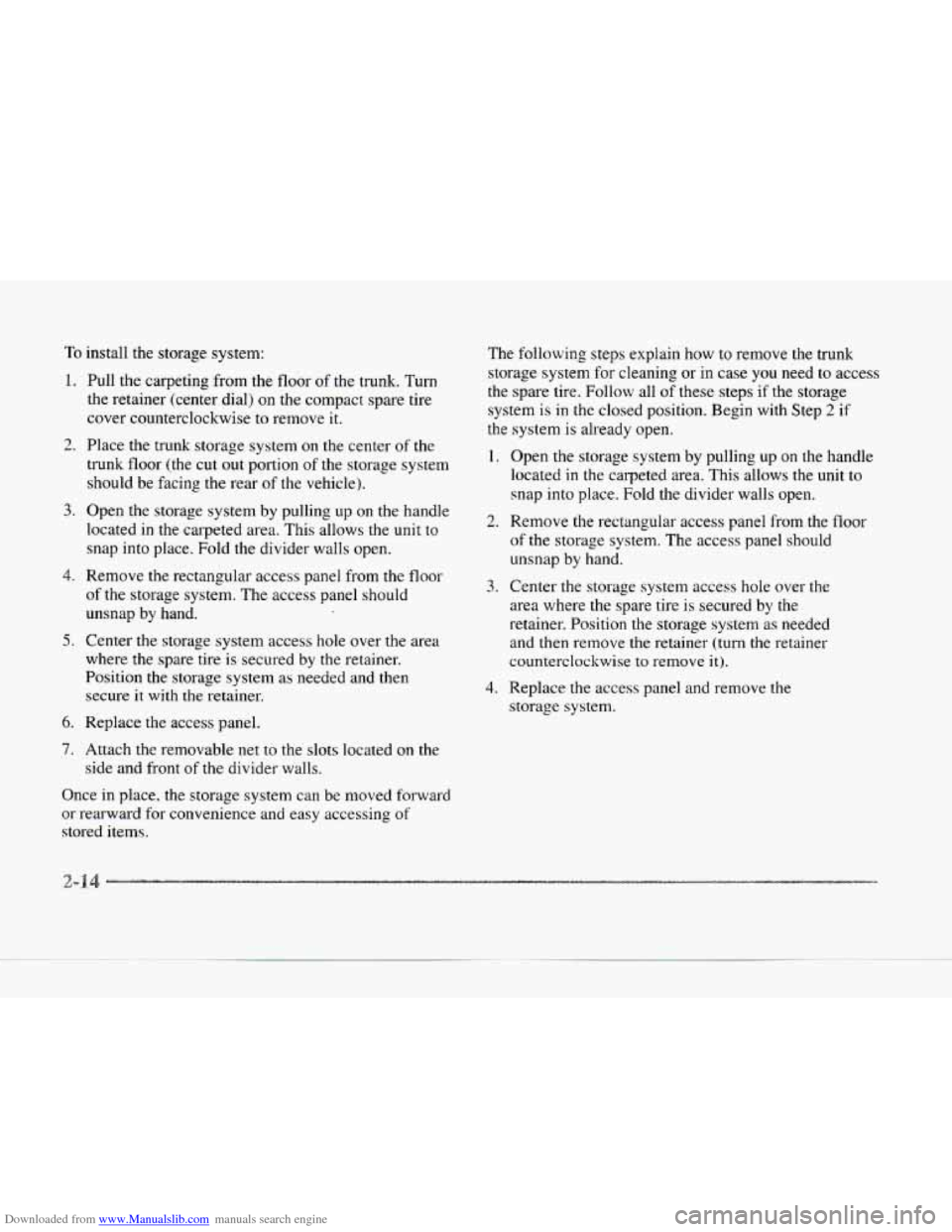
Downloaded from www.Manualslib.com manuals search engine To install the storage system:
1.
2.
3.
4.
5.
6.
7.
Pull the carpeting from the floor of the trunk. Turn
the retainer (center dial) on the compact spare tire
cover counterclockwise
to remove it.
Place the trunk storage system on the center of the
trunk floor (the cut
out portion of the storage system
should be facing the rear
of the vehicle).
Open the storage system by pulling up on the handle
located in the carpeted area. This allows the unit to
snap into place. Fold the divider walls open.
Remove
the rectangular access panel from the floor
of the storage system. The access panel should
unsnap by hand.
Center
the storage system access hole over the area
where the spare tire is secured by the retainer.
Position the storage systetn as needed and then
secure it with the retainer.
Replace
the access panel.
Attach the removable
net to the slots located on the
side and front
of the divider walls.
Once in place. the storage system can be moved forward
or rearward for convenience and easy accessing of
stored items. The
following steps explain
how to remove the trunk
storage system
for cleaning or in case you need to access
the spare tire. Follotv all of these steps if the storage
system is in the closed position. Begin with Step
2 if
the system is already open.
1.
2.
3.
4.
Open the storage system by pulling up on the handle
located in the carpeted area. This allows the unit
to
snap into place. Fold the divider walls open.
Remove the rectangular access panel from the floor
of the storage system. The access panel should
unsnap
by hand.
Center the storage system access hole over the
area where the spare tire
is secured by the
retainer. Position the storage system as needed
and then remove the retainer (turn the retainer
counterclockwise
to remove it).
Replace the access panel and remove the
storage system.
Page 232 of 370
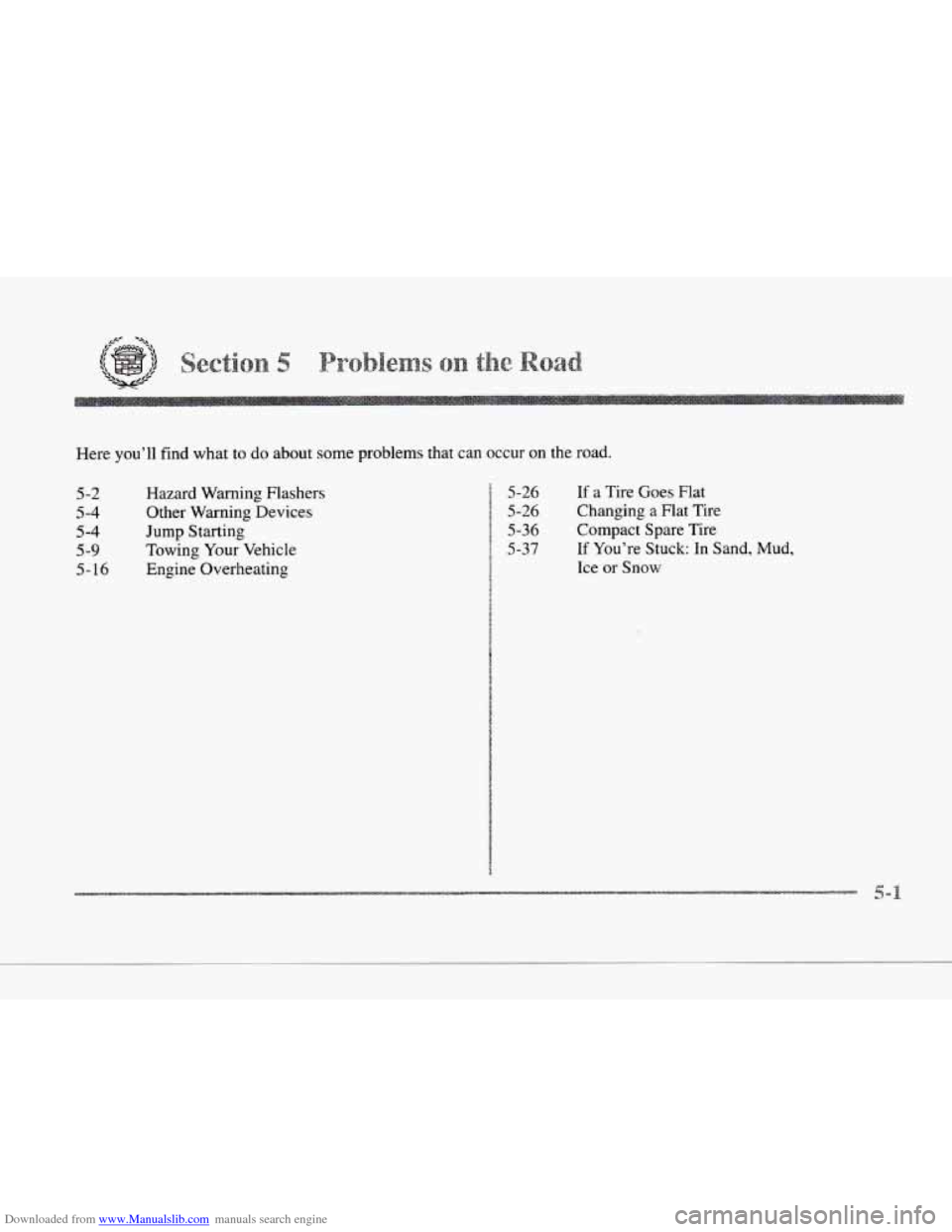
Downloaded from www.Manualslib.com manuals search engine c
c
Here you’ll find what to do about some problems that can occur on the road.
c
c
5-2 Hazard Warning Flashers
5-4 Other Warning Devices
5-4 Jump Starting
5-9 Towing Your Vehicle
5-16 Engine Overheating 5-26
5-26
5-36
5-37
If a
Tire Goes Flat
Changing a Flat Tire
Compact Spare Tire
If You’re Stuck: In Sand, Mud,
Ice or Snow
Page 258 of 370
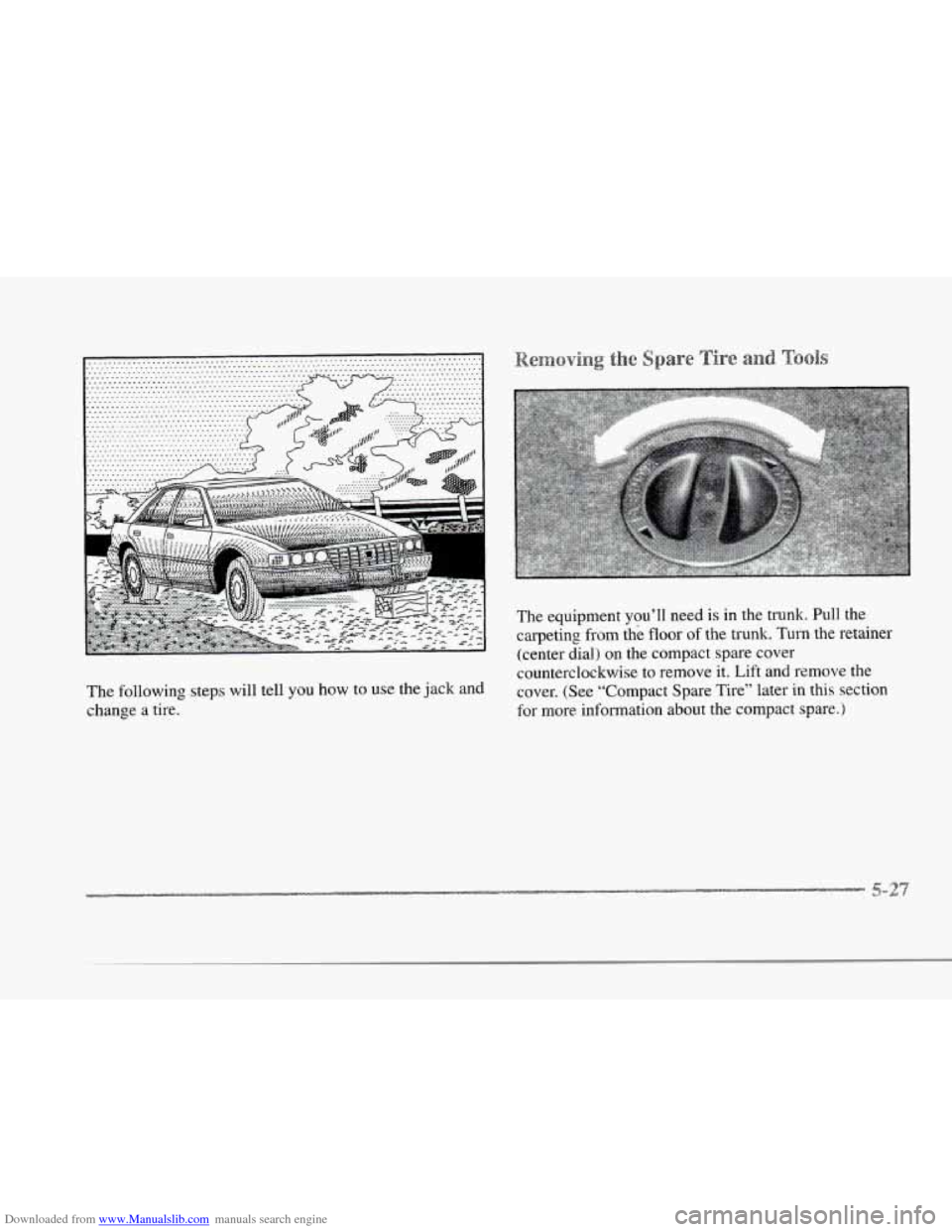
Downloaded from www.Manualslib.com manuals search engine r
r
r
r
r
r
r
r
The following steps will tell you how to use the jack and
change a tire.
e s
The equipment you’ll need is in the trunk. Pull the
carpeting from the
floor of the trunk. Turn the retainer
(center dial) on the compact spare cover
counterclockwise to remove it. Lift and remove the
cover. (See “Compact Spare
Tire” later in this section
for
more information about the compact spare.)
Page 262 of 370

Downloaded from www.Manualslib.com manuals search engine r
r
r
I-
r
r
r
r
11 .O INCHES
(279 mm)
7.0 INCHES
(177 mm)
3. Position the jack under the vehicle and raise the jack
lift head until it
fits firmly into the notch in the
vehicle’s frame nearest the flat tire.
Put the compact spare tire near
you.
4. Raise the vehicle by turning the jack handle
clockwise. Raise the vehicle far enough
off the
ground €or the spare tire
to fit under the vehicle.
5. Remove all wheel nuts and take off the flat tire.
Page 265 of 370
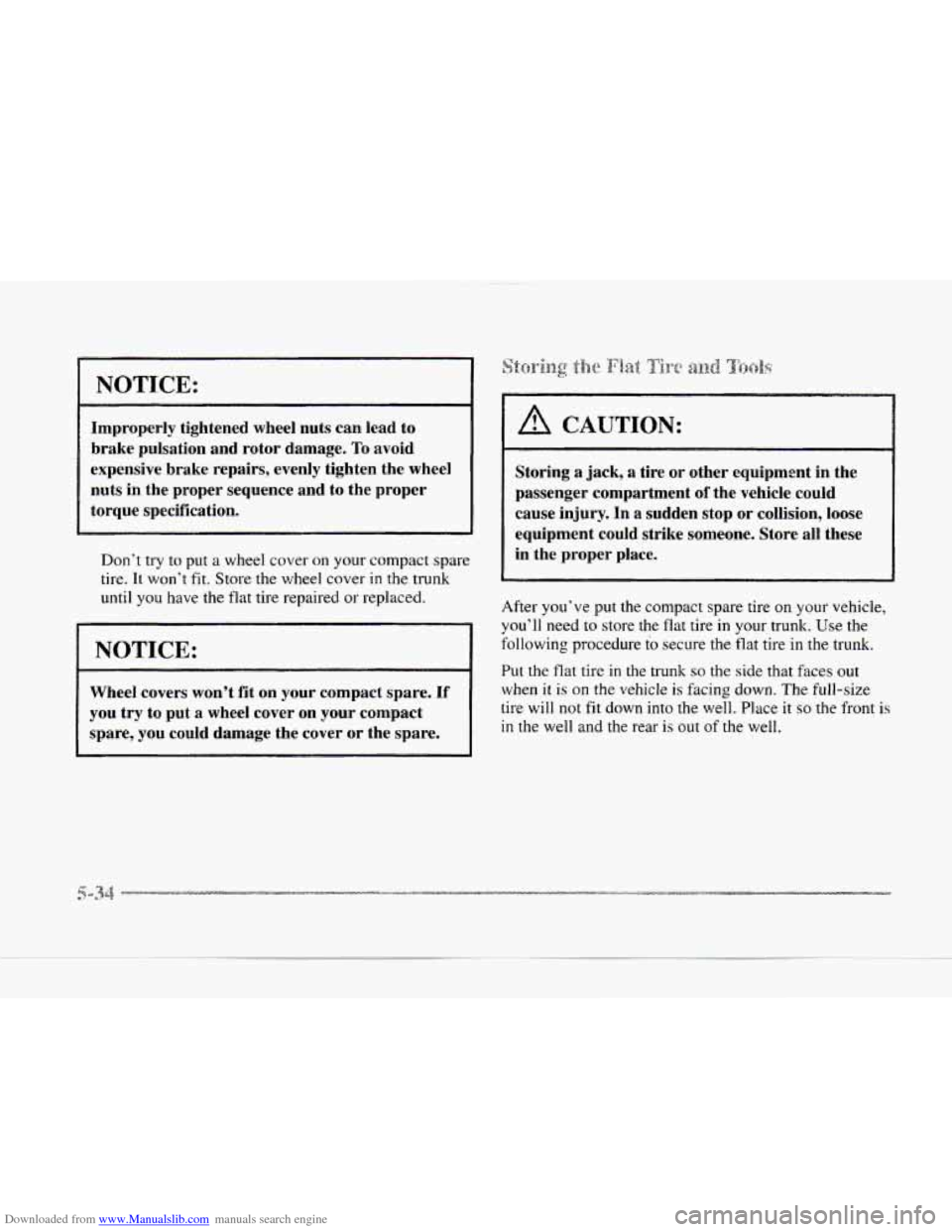
Downloaded from www.Manualslib.com manuals search engine NOTICE:
Improperly tightened wheel nuts can lead to
brake pulsation and rotor damage.
To avoid
expensive brake repairs, evenly tighten the wheel
nuts in the proper sequence and to the proper
torque specification.
Don’t try to put a wheel cover on your compact spare
tire.
It won’t fit. Store the wheel cover in the trunk
until you have the flat tire repaired or replaced.
I NOTICE:
Wheel covers won’t fit on your compact spare. If
you try to put a wheel cover on your compact
spare, you could damage the cover or the spare. Storing
a jack, a tire or other
equipment in the
passenger compartment
of the vehicle could
cause injury. In
a sudden stop or collision, loose
equipment could strike someone. Store all these
in the proper place.
After you’ve put the compact spare tire on your vehicle,
you’ll need to store the flat tire in your trunk. Use the
following procedure
to secure the flat tire in the trunk.
Put the flat tire in the trunk so the side that faces out
when it is on the vehicle is facing down. The full-size
tire will
not fit down into the well. Place it so the front is
in the well and the rear is out of the well.
Y
Page 266 of 370
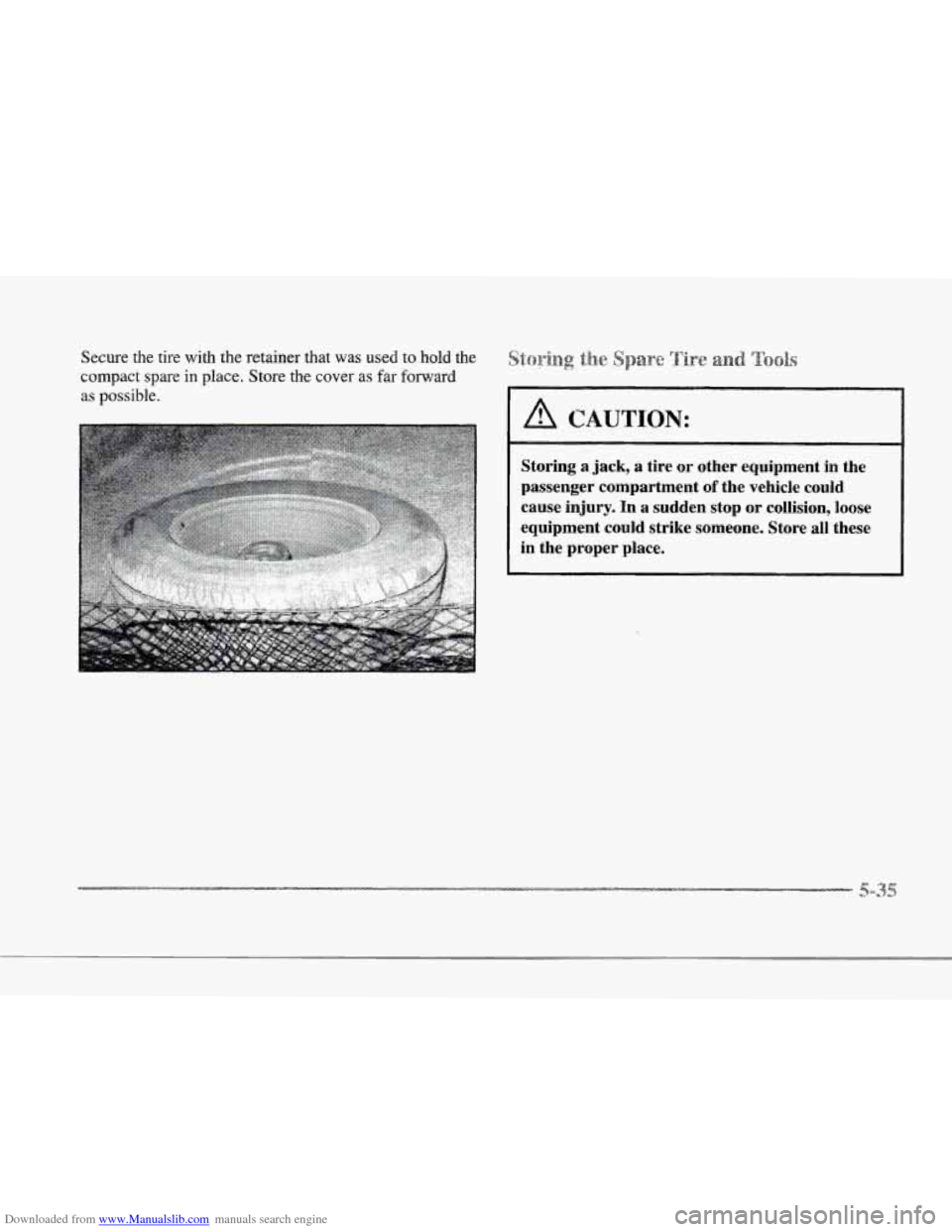
Downloaded from www.Manualslib.com manuals search engine r
r
r
r
r
r
r
Secure the tire with the retainer that was used to hold the
compact spare in place. Store the cover as
far forward
as possible. _1
A CAUTION:
Storing a jack, a tire or other equipment in the
passenger compartment
of the vehicle could
cause injury. In
a sudden stop or collision, loose
equipment could strike someone. Store all these
in the proper place.
Page 267 of 370
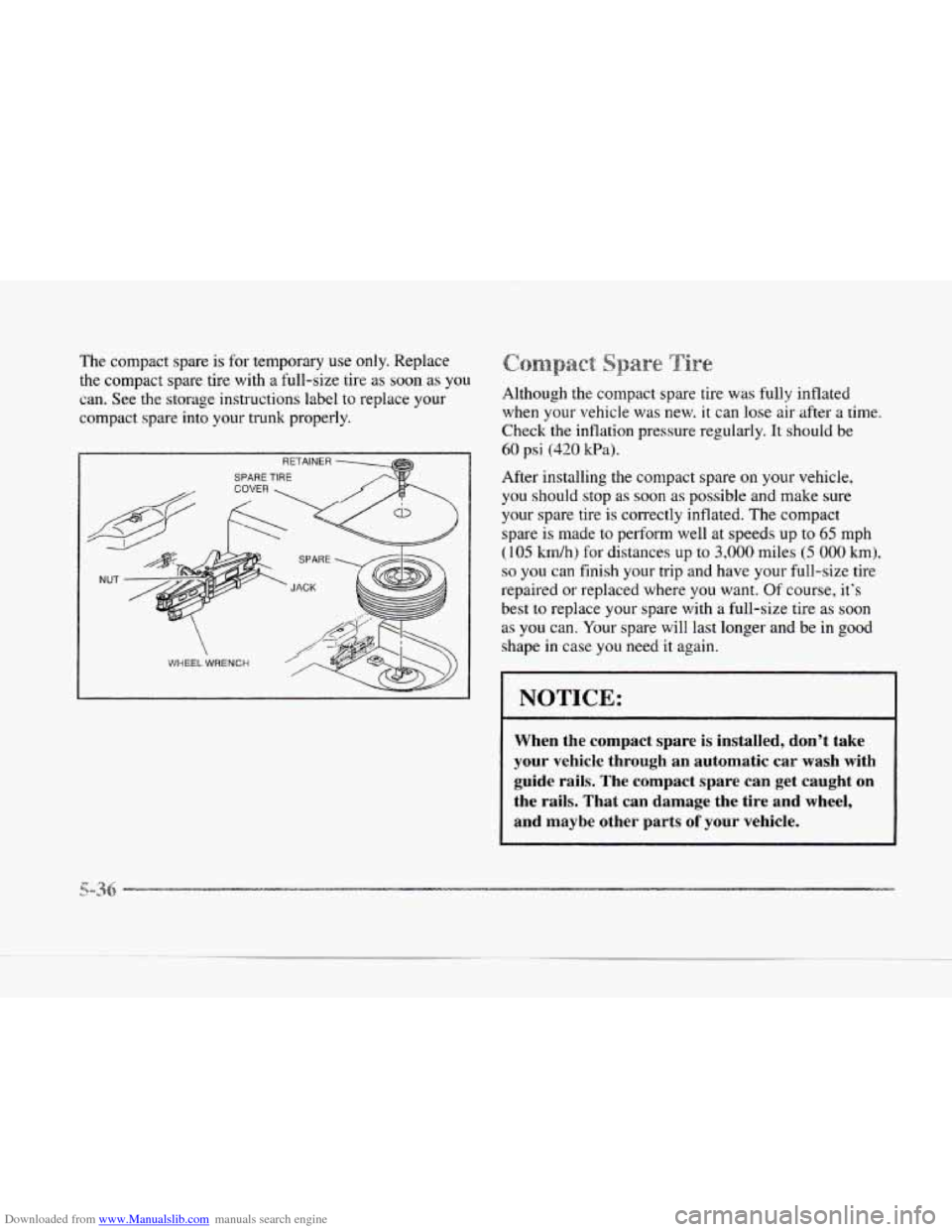
Downloaded from www.Manualslib.com manuals search engine The compact spare is for temporary use only. Replace
the compact spare tire with
a full-size tire as soon as you
can. See the storage instructions label to replace your
compact spars into your trunk properly.
RETAINER
SPARE TIRE
WHEEL WRENCH
Although the compact spare tire was fully inflated
when your vehicle was new.
it can lose air after a time.
Check the inflation pressure regularly.
It should be
60 psi (420 kPa).
After installing the compact spare on your vehicle,
you should stop as soon as possible and make sure
your spare tire
is correctly inflated. The compact
spare is made
to perform well at speeds up to 65 mph
(1 05 km/h) for distances up to 3,000 miles (5 000 km),
so you can finish your trip and have your full-size tire
repaired or replaced where
you want. Of course, it’s
best
to replace your spare with a full-size tire as soon
as you can. Your spar!: will last longer and be in good
shape in case you need it again.
NOTICE:
When the compact spare is installed, don’t take
your vehicle through an automatic car wash with guide rails.
The compact spare can get caught on
the rails. That can damage the tire and wheel,
and maybe other parts
of your vehicle.
I
L.
Page 268 of 370
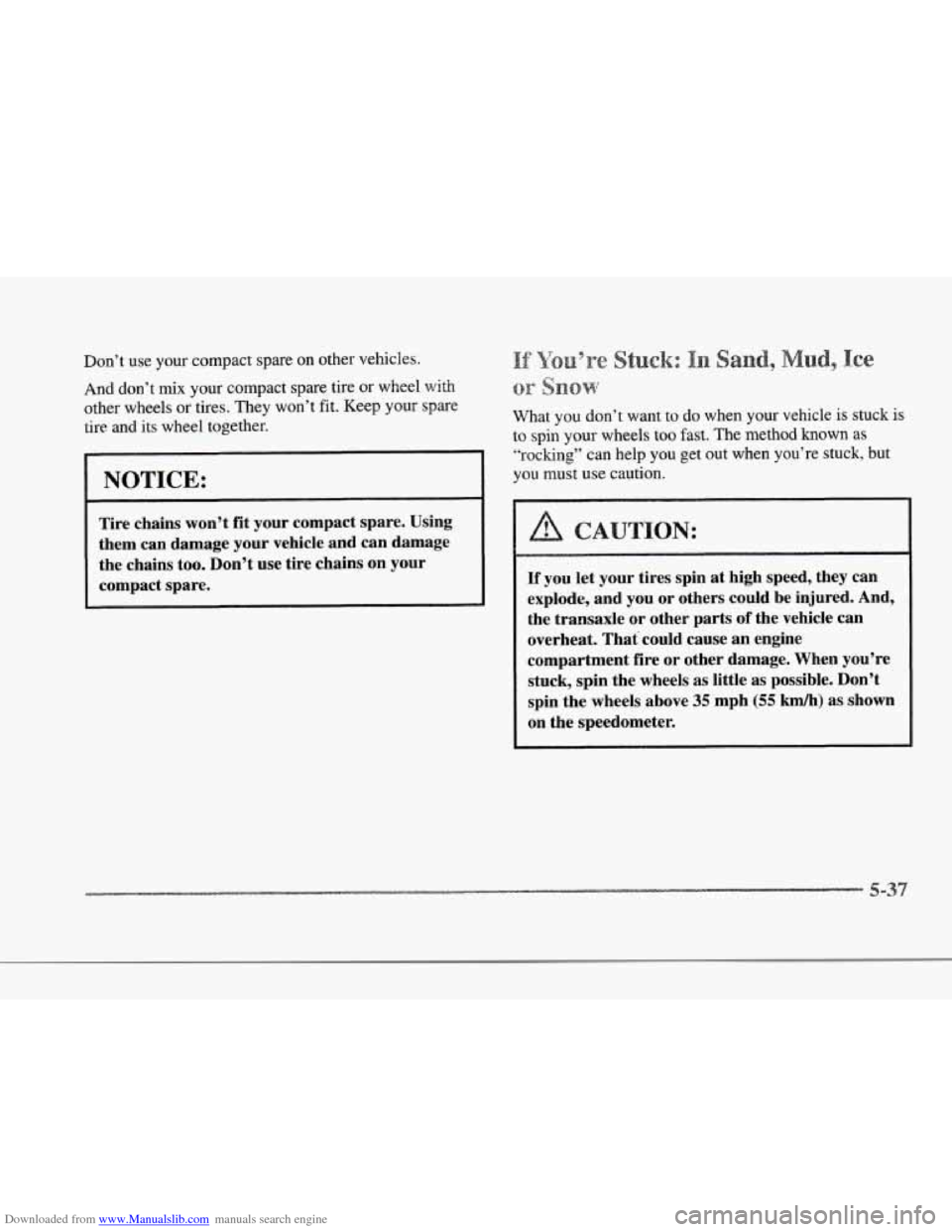
Downloaded from www.Manualslib.com manuals search engine r
r
r
r
r
r
r
r
Don’t use your compact spare on other vehicles.
And don’t mix your compact spare tire or wheel, with
other wheels or tires. They won’t fit. Keep your spare
tire and its wheel together.
I 1
I NOTICE: I
Tire chains won’t fit your compact spare. Using
them can damage your vehicle and can damage
the chains too. Don’t use tire chains on your
compact spare.
8) I) 9
What you don’t want to do when your vehicle is stuck is
to spin your wheels too fast. The method known as
”rocking” can help you get out when you’re stuck, but
you must
use caution.
/c CAUTION:
If you let your tires spin at high speed, they can
explode, and you or others could be injured. And,
the transaxle or other parts
of the vehicle can
overheat. That could cause an engine
compartment fire or other damage. When you’re
stuck, spin the wheels as little as possible. Don’t
spin the wheels above
35 mph (55 km/h) as shown
on the speedometer.
Page 310 of 370

Downloaded from www.Manualslib.com manuals search engine 1.
c
Check your tires once a month or more.
Don’t forget your compact spare tire. It should be at
60 psi (420 kPa).
Use a good quality pocket-type gage to check tire
pressure.
You can’t tell if your tires are properly inflated
simply by looking at them. Radial tires may look
properly inflated even when they‘re underinflated.
Be sure
to put the valve caps back on the valve
stems. They help prevent leaks by keeping out dirt
and moisture.
Tires should be rotated every
4,000 to 8,000 miles
( IO 000 to 13 000 km). Any time you notice unusual
wear, rotate your tires
as soon as possible and check
wheel alignment. Also check
for damaged tires or
wheels.
See “When It’s Time for New Tires” and
”Wheel Replacement” later
in this section for
more information. The purpose
of regular rotation is to achieve more
uniform wear for
all tires on the vehicle. The first
rotation
is the most important. See “Scheduled
Maintenance Services’‘
in thc Maintcnance Schedule
booklet for
schedulcd rota~io~~ inttwals.
When rotating your tires. al\vays use the con-t‘ct rotation
pattern
shown here.
Don’t include the compact spare tire
in your tire rotation.
After the tires have been rotated, adjust
the front and
rear inflation pressures
as show on the Tire-Loading
Information label. Make certain that all wheel
nuts
are properly tightened. See “Wheel Nut Torque” in
the Index.
6-3
Page 312 of 370
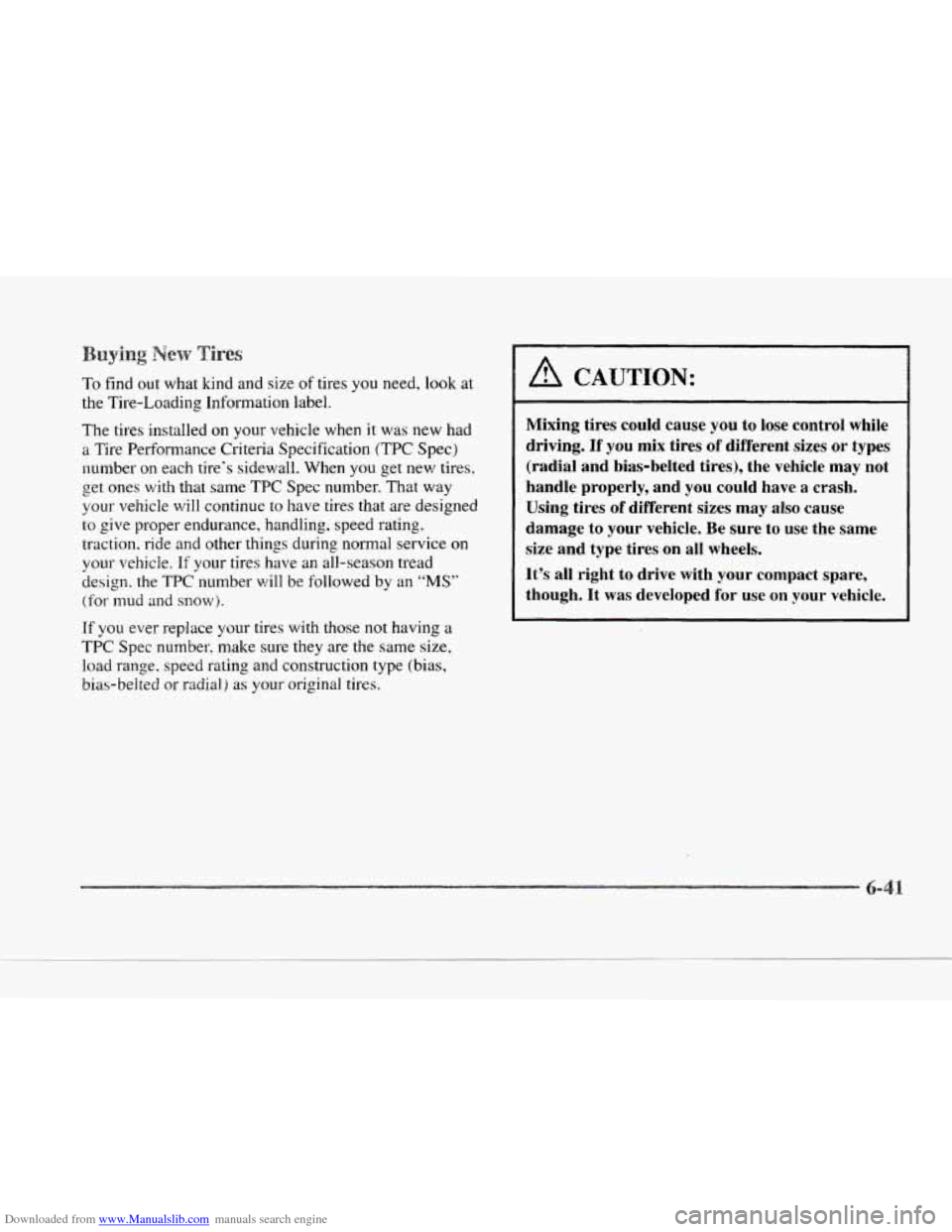
Downloaded from www.Manualslib.com manuals search engine LI
c
Y
To find out what kind and size of tires you need, look at
the Tire-Loading Information label.
The tires installed on your vehicle when
it was new had
a Tire Performance Criteria Specification (TPC Spec)
number
on each tire's sidewall. When you get new tires,
your vehicle will continue to have tires that are designed
to give proper endurance: handling, speed rating.
traction. ride and other things during normal service
on
your vehicle. If your tires have an all-season tread
design. the
TPC number will be followed by an "MS"
(for mud and snow).
e oet ones with that same TPC Spec number. That way
If you ever replace your tires with those not having a
TBC Spec number, make sure they are the same size,
load range. speed rating and construction type (bias,
bias-belted or radial)
as your original tires.
I A CAUTION:
Mixing tires could cause you to lose control while
driving.
If you mix tires of different sizes or types
(radial and bias-belted tires), the vehicle may not
handle properly, and you could have a crash.
Using tires
of different sizes may also cause
damage to your vehicle. Be sure
to use the same
size and type tires on
all wheels.
It's all right to drive with
your compact spare,
though. It was developed for use
on your vehicle.